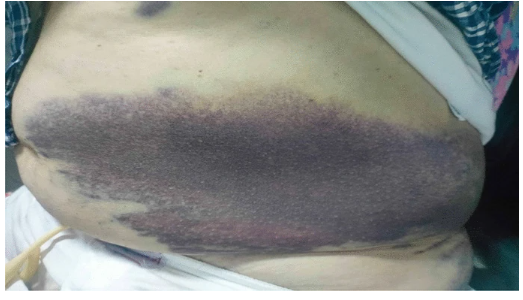Case presentation
A 69-year-old Tunisian man visited the emergency room with acute left leg pain that was impeding his mobility owing to an ecchymosis measuring 5×6 cm that had formed spontaneously 5 days earlier. However, the patient denied any trauma.
He had a family history of gastric cancer and no relevant psycho-social background. Thirty days before the consultation, he got the second dosage of the CoronaVac-SinoVac vaccine. Three weeks after he had gotten the vaccine, the patient recalled that a little ecchymosis had spontaneously appeared and vanished.
Furthermore, doctors discovered two additional ecchymoses during a more thorough physical examination at the emergency department (ED). One at the inner face of the right forearm, measuring 15 x5 cm from the wrist to the elbow. The other one was at the left flank of the abdomen, measuring 40 x12 cm from the left iliac crest.
Investigation
The doctors performed soft tissue ultrasonography that revealed a hyperechoic infiltration of ecchymosis at the left inner thigh.
The total blood count revealed increased reticulocytes at 130 000/mm3 and a normal platelet count, along with macrocytic normochromic anaemia. Moreover, haemoglobin was 8.4 g/dl, with mean corpuscular volume at 103 fl, and mean corpuscular haemoglobin at 32 pg/cell. Doctors also ordered prothrombin Time (PT), aPTT, and coagulation factors. This revealed an isolated prolonged aPTT.
They performed a CT-total body scan to rule out any potential organic secondary causes of haemophilia A that might exist. Anti-nuclear antibody, anti-extractable nuclear antigen, and anti-double-stranded DNA tests as well as tests for lupus anticoagulant disorders and chronic infectious diseases came back negative. Additionally, there was no recent medication use or history of using illicit drugs.
Prognosis
After a presumptive diagnosis of acquired haemophilia A (AHA), systemic corticosteroid therapy was prescribed for three days. The dosage was 80 mg of prednisolone. After this, the medication was given at a dose of 1 mg/kg. To treat the anaemia, the doctors transfused the patient red blood cells. In the absence of bleeding that could have been life-threatening, bypass therapy wasn’t considered.
Due to the patient’s advanced age, lack of a history of bleeding or heparin-based therapy, and the spontaneous occurrence of hematomas and ecchymoses linked to the isolated prolonged PTT. The doctors ordered a coagulation screen (available 13 days later). This revealed an isolated decrease of factor VIII (FVIII) activity (F VIIIc equal to 1%).
Doctors confirmed the absence of FVIII with two different samples. They used the modified Bethesda test to titrate the presence of an FVIII inhibitor and confirm the diagnosis of AHA.
The patient showed very slight improvement after 17 days of corticosteroid therapy, therefore doctors started a course of rituximab 375 mg/m2 once a week for four weeks.
After receiving the first dosage of rituximab, doctors discharged the patient and asked him to attend weekly check-ups at the outpatient clinic. As a result of the delayed action of the second dose of rituximab, there was an increase in the PTT with no hemorrhagic syndrome. This prevented doctors from stopping the course of treatment. After 18 days of treatment with corticosteroids combined with rituximab, the patient presented for follow-up. Follow-up revealed a significant clinical improvement (healing of the ecchymoses and no return of additional bleeding symptoms) and normalization of a PTT. There were no negative consequences of the treatment.
Conclusion
This article emphasizes further potential safety issues with the COVID-19 vaccine. Although the benefits of vaccination far outweigh the risks, post-vaccination surveillance is crucial to identify any potential side effects. Clinicians should consider a prolonged PTT with or without spontaneous bleeding as AHA because, if left untreated, this condition could be fatal.
Acquired Haemophilia
AHA is a rare autoimmune illness caused by the generation of autoantibodies against FVIII. It primarily affects the elderly and can be fatal if left untreated. With an isolated prolonged PTT with or without bleeding, doctors should suspect AHA and confirm it by looking for an FVIII inhibitor. Acquired haemophilia has been identified as being linked to genetic predispositions, certain underlying conditions (including autoimmune disorders, respiratory diseases, and malignancies), infections, or pregnancies in 43.6% to 51.9% of cases.
Doctors often treat haemophilia by using immunosuppressive drugs including corticosteroids, rituximab, and cyclophosphamide. In this case, doctors used low-dose rituximab (100 mg/week for 4 weeks) in combination with corticosteroids to treat the patient. To reduce the risk of side effects, particularly neutropenia, which could be harmful to the elderly who have a higher susceptibility to infections, doctors prefer this regimen over the regular dose (375 mg/m2).
Prospect: Covid-19 and Haemophilia
Despite numerous trials, there is currently no medication that can effectively treat COVID-19. Pharmaceutical corporations are engaged in an unparalleled race to create efficient vaccinations as a result. People questioned the safety and efficacy of vaccinations as a result of the emergency use authorization granted to many vaccines. Following the COVID-19 vaccination, there have been numerous cases of AHA reported in the literature. It is currently uncertain whether COVID-19 vaccinations cause a specific auto-immune phenomenon that leads to this autoimmune disease.
This case highlights some of the earliest instances of acquired haemophilia following an inactivated COVID-19 immunization (Sinovac-CoronaVac), to the best of our knowledge. In this instance, it happened 30 days following the second Sinovac-CoronaVac vaccination dose.
There are currently no post-vaccination monitoring programs that advocate screening for clinical or biochemical signs of AHA or any of other rare autoimmune illnesses that are likely connected to COVID-19 vaccinations. When presented with an isolated prolonged PTT, doctors must evaluate the diagnosis of acquired haemophilia. The goal of treatment is to stop any bleeding while also addressing the underlying cause.




